Dive
into certain areas along the Bay of Fundy coast, for example, “and
within 20 minutes you can pick out five, six, seven different phylums—you
are actually seeing all these different planets of life,” Leslie
says. The undersea repertoire includes everything from rock crabs,
sea ravens and fan worms to northern lampshells, anemones, eel pouts
and tunicates. And unlike the more tropical locales where divers and
snokelers abound, he adds, “the adventure of photographing in
cold water environments is that it is so rarely done.”
Leslie, who lives in Granville Beach, Nova Scotia, has worked for years as a land-based wildlife photographer and continues to publish widely in North American publications. His foray into undersea photography began in the 1990s after viewing the works of National Geographic undersea photographer David Doublilet. “Hawksbill Turtle with Remoras,” depicting a sea turtle bathed in light, was a particularly poignant photograph. “I took one look a that amazing image and said to myself, ‘This is exactly what I want to do.’”
He set out and earned his SCUBA and instructors certificates in the mid-90s and dives mostly in the Bay of Fundy—often in winter. For several years he worked as a sea urchin diver off Brier Island and other locations making more than 2,000 dives. At the same time, he ran a diving supply shop and trained and certified hundreds of other divers. Bit by bit, he taught himself the dexterous art of taking photographs in the Bay’s often cranky waters.
As anyone who has so much as dipped a toe in the Bay of Fundy can attest, swimming, much less diving there can be a character-building experience. The waters of the northern Gulf of Maine and Atlantic Canada are cold even in the summer. Because it lies somewhere between two extremes in temperature, tropical and arctic, the region harbors an unusual mixture of creatures, drawn to the plant and animal plankton that thrive in its nutrient-rich waters.
While such marine life may be present in large quantities, it can still be hard to find. The green-tint that results from the abundance of phytoplankton can result in poor underwater visibility. Even so, Leslie says, visibility in many areas can match or surpass spots to the south. “I’ve been diving in Grand Passage [off Brier Island] in mid-January where visibility was up to 75 feet. One of my favorite places is the south coast of Cape Breton where you can get from 40 to 50 feet visibility.”
Still, there are tremendous challenges to capturing marine life on film, he adds. “You’ve got time constraints and air supply constraints. Then there’s the most difficult thing to master: lighting.” To capture those vibrant colors, Leslie uses both natural and artificial lighting. Though you can work with the natural light to about 30 feet, “the warmer colors, the reds and oranges fade the deeper you go,” he explains. For most of the time, he uses multiple flash strobes encased in a waterproof housing. To be able to steady the equipment and focus, he adds, photographers must be adept at maintaining buoyancy and controlling their breathing.
Leslie’s experiences as an urchin diver have trained him well for working in strong currents. Once while diving during ebb tide he got caught inside a whirlpool that spun him for several seconds before releasing him. “You have to be very careful and have a good instinct for troubled waters,” he says.
A life-long conservationist, he often keeps certain spots, including one rock cropping where he found a colony of seals, to himself, knowing the animals are all too vulnerable to the wrath of some fishermen, who will shoot a seal if they perceive it as a competitor. Leslie has also witnessed the devastating impact that fishing trawlers have had on the ecosystem. “You’ll be swimming along in this gorgeous rich habitat then all of the sudden it becomes this desert,” caused by trawlers scouring the seafloor, he says. In this regard, Leslie’s images serve to educate and instill a deep appreciation of the richness of life not far from our shores and remind us of all we have to lose.
Leslie’s sharp sense of composition and color give us an intimate look at both habitant and habitat. Whether it is a rock crab camouflaged against pink coralline algae or a rock gunnel drifting along steep boulders where it deposits eggs, the images intuitively reveal the connections and gracefulness of life below the cold water’s surface. |
|
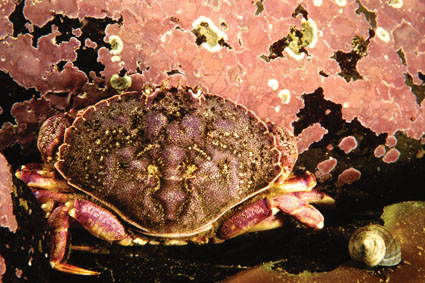
Rock crab on pink coralline algae, Sandy Cove, Bay of Fundy
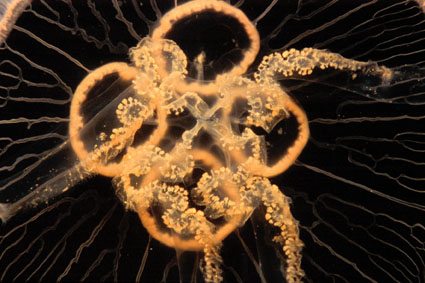
Moon Jellyfish, Aurelia aurita, Grand Passage, Nova Scotia
Most numerous in the latter part of summer, these jellyfish swim gracefully along the surface of nearshore waters. The four gonads, or reproductive organs, are shaped like four leafed clovers; white in females and pink in males.
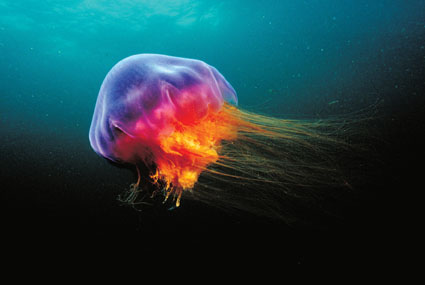
Photographed off the coast of Labrador in 32-degree Fahrenheit water, Leslie found himself amid a swarm of lion’s mane jellyfish. The scientific name, capillata, means “hair” and refers to the long tentacles, equipped with stinging cells, used to capture food and ward off predators.
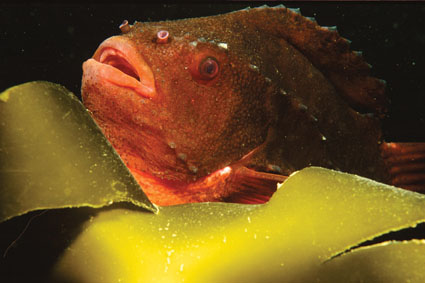
Male Lumpfish, Cyclopterus lumpus, Grand Passage, Nova Scotia
Lumpfish attach to seaweed or rocks, with a suction disc. They spawn in summer leaving a nest of eggs in seaweeds; males often guard the eggs until they hatch. Colors vary from blue to brown to red in breeding males.
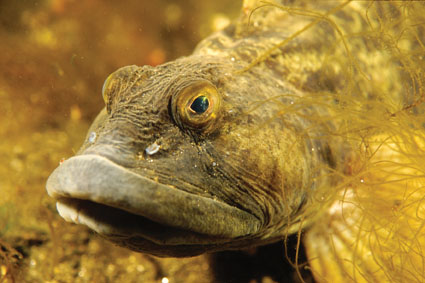
Eel pout, Macrozoarces americanus, Northwest Ledge, off Brier Island
Also known as ocean pouts, these fish live in range of temperatures including sub-zero. They get their name from the pouting appearance of their lower lip.
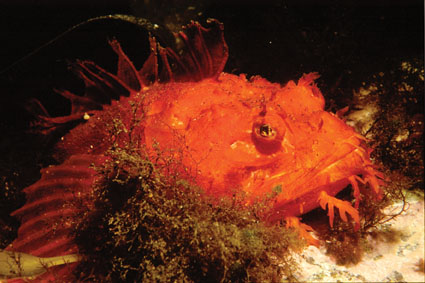
Atlantic sea raven, Hemitripterus americanus, Petite Passage, Bay of Fundy
Sea Ravens may vary in color from blood red to yellowish brown. They are present throughout the water column and are veracious eaters of molluscs, crustaceans and fish.
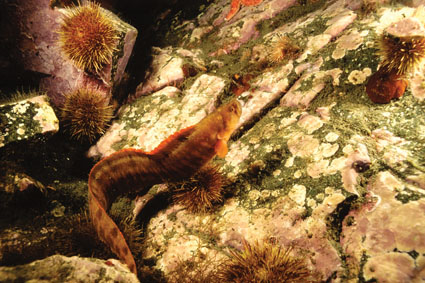
Rock Gunnel, Pholis gunnelis, Broad Cove, Bay of Fundy
Common along the coves of the Bay of Funny, gunnels lay their eggs in mussel shells and between rocks. Larvae hatch in four weeks, swim in plankton in the summer, then hide among rocks in the autumn. |

